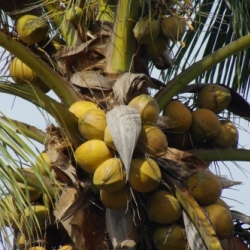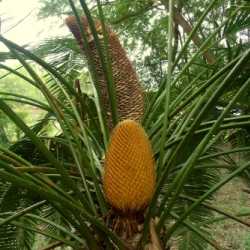Seed plants or seed-bearing plants, also called spermatophytes or Spermatophyta, are vascular plants with numerous members belonging to the lignophytes or woody plants.
They have the natural ability to produce seeds, a characteristic that likewise distinguishes them from earlier plants.
The seed has been defined as an embryo surrounded by nutritive tissue and enveloped by a seed coat.
The embryo is an immature diploid sporophyte developing from the zygote (Simpson 2010).
Those which do not produce seeds are called seedless plants or non-seed plants.
They consist of both nonvascular and vascular plants and reproduce by means of spore.
The spore is defined by Simpson (2010) as a haploid cell that, in the land plants, originates from meiotic divisions of sporocytes within a sporangium, ultimately growing into a gametophyte.
But these spermatophytes did not just appear spontaneously.
In fact, all plants are products of evolution and different groups with distinctive characteristics evolved at different periods of time.
Before these seed-bearing plants were completely established, the dominant vegetation consisted of the bryophytes and the ferns and allies which are both seedless and flowerless.
Based on archaeological evidence, the seed plants came into first existence about 360 million years ago in the later part of the Devonian period.
However, they did not immediately establish their population, and even after the Carboniferous period (354-290 million years ago), they appear as miniatures compared to the spore-bearing giants both in number and plant size (Kesseler and Stuppy 2009).
It was these dense forests of tree-like ferns and other members of the so-called cryptogams that formed many of the coal deposits that are mined today for use as a source of energy (Went and The Editors of Life 1963).

During the period spanning the later part of the Carboniferous and the start of the Permian (248-290 million years ago), the climate became drier.
The conditions became unfavorable for the reproduction and growth of the spore-forming plants but favorable to the seed plants.
As a result, the seed-bearing plants grew large and soon became the dominant species as it is today (Kesseler and Stuppy 2009).
Water is essential to fertilization with spores because the sexual gametes have to swim to find each other and unite, but it is not a requirement in seed formation.
Pollination, the transfer of pollen grains from the male to the female reproductive organ, which precedes fertilization, is accomplished in many ways.
The wind, insects, birds, bats, and other animals serve as vectors or agents of pollination.
In relation to species perpetuation, therefore, the seed is one of the plants’ most ingenious and powerful evolutionary innovations. Reproduction is the main function of seeds.
Click here to read Types of Pollination and Pollen Vectors
Types of Seed Plants: Angiosperms and Gymnosperms
The spermatophytes are commonly grouped into two types: Gymnospermae or gymnosperms and Angiospermae or angiosperms.
The words angiosperm and gymnosperm have their root in the Greek words angio meaning vessel or box; gymno meaning naked or bare; and sperm meaning seed, semen, or male reproductive cells (Borror 1960).
The gymnosperms are more ancient in terms of evolutionary history.
It was some 360 million years ago that the spermatophytes first appeared.
But the earliest evidence of angiosperms is those of fossilized pollen grains from the Cretaceous period about 140 million years ago and flowers from sediments about 130 million years ago (Simpson 2010).

The phyla (or divisions) of the plant kingdom that comprise the gymnosperms are the Cycadophyta (ex. Cycas revoluta), Ginkgophyta (i.e., Ginkgo biloba), Pinophyta (ex. Pinus spp.), and Gnetophyta (ex. Gnetum gnemon) (Moore et al. 2003).
However, Simpson (2010) listed only three having placed the gnetophytes under Coniferae (also called Pinophyta or Coniferophyta).
He noted that the exact placement of Gnetophyta (or Gnetales) is still uncertain.
The angiosperms (Angiospermae, flowering plants, or covered-seed plants) consist of the division Anthophyta, also called Magnoliophyta.
Two Types of Seed Plants
These two types of seed plants are further distinguished:
Similar to bryophytes and the ferns and allies, the gymnosperms have no flowers.
They are also described as plants with naked seeds because during pollination the ovule is not enclosed by the carpel except some kind of scales during development.
Consequently, the mature seed is not surrounded by any tissue, and the outer part of the skin that is visible consists of the seed coat, the outermost part of a seed.
In contrast, the angiosperms have evolved flowers hence they are also called flowering plants.
In addition, these plants are described as those which produce or are capable of producing enclosed or covered seeds.
Unlike those in the gymnosperms, these seeds are not immediately visible because they are enclosed and concealed by a fruit.
The seeds of the angiosperms develop after double fertilization in flowers which are present only in these plants.
It is the fruit, particularly the pericarp, that covers the seed in cereals.
REFERENCES
- BORROR DJ. 1960. Dictionary of Word Roots and Combining Forms. Mountain View, CA: Mayfield Publishing Company. 134 p.
- KESSELER R, STUPPY W. 2009. Seeds: Time Capsules of Life. Buffalo, New York: Firefly Books. 264 p.
- MOORE R, CLARK WD, VODOPICH DS. 2003. Botany. 2nd ed. New York, NY: McGraw-Hill Companies, Inc. 919 p.
- SIMPSON MG. 2010. Plant Systematics. 2nd ed. Burlington, MA: Elsevier Inc. 740 p.
- WENT FW, THE EDITORS OF LIFE. 1963. The Plants. New York: Time Incorporated. 194 p.
